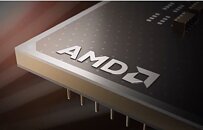Friday, September 18th 2020

AMD "Vermeer" Zen 3 Processors Branded Under Ryzen 5000 Series?
AMD is allegedly preparing to market its next-generation Socket AM4 desktop processors based on the "Vermeer" MCM, under the Ryzen 5000 Series. The "Vermeer" MCM implements the company's "Zen 3" microarchitecture in the client segment. It features up to two 7 nm-class CPU complex dies with up to 8 cores, each, and a refreshed cIOD (client IO die). AMD has allegedly improved the cIOD with a new memory controller and several new toggles that improve memory bandwidth. The cIOD combines a PCI-Express Gen 4 root complex with a dual-channel DDR4 memory controller. With "Zen 3," AMD is also introducing an improved boosting algorithm, and an improved SMT feature.
Coming back to AMD's rumored nomenclature, and we could see the company bumping up its processor model numbers to the 5000 series for equivalent core-counts. For example, the Ryzen 9 5900X is a 12-core/24-thread part, much like the 3900X; whereas the Ryzen 7 5800X is an 8-core/16-thread part. This flies in the face of rumors that AMD could take advantage of the 8-core CCX design of the "Zen 3" microarchitecture by carving out 10-core parts using two CCDs with 5 cores enabled, each. The reason AMD is skipping the 4000 series numbering with "Vermeer" probably has something to do with "Renoir" taking up many of the 4000-series model numbers. "Renoir" is based on "Zen 2," and recently made its desktop debut, albeit as an OEM-exclusive. The company is planning to introduce certain 4000G series models to the DIY retail segment. AMD is expected to announce its first "Zen 3" client-segment processors on October 8, 2020.
Sources:
VideoCardz, Patrick Schur (Twitter)
Coming back to AMD's rumored nomenclature, and we could see the company bumping up its processor model numbers to the 5000 series for equivalent core-counts. For example, the Ryzen 9 5900X is a 12-core/24-thread part, much like the 3900X; whereas the Ryzen 7 5800X is an 8-core/16-thread part. This flies in the face of rumors that AMD could take advantage of the 8-core CCX design of the "Zen 3" microarchitecture by carving out 10-core parts using two CCDs with 5 cores enabled, each. The reason AMD is skipping the 4000 series numbering with "Vermeer" probably has something to do with "Renoir" taking up many of the 4000-series model numbers. "Renoir" is based on "Zen 2," and recently made its desktop debut, albeit as an OEM-exclusive. The company is planning to introduce certain 4000G series models to the DIY retail segment. AMD is expected to announce its first "Zen 3" client-segment processors on October 8, 2020.

38 Comments on AMD "Vermeer" Zen 3 Processors Branded Under Ryzen 5000 Series?
5 or 5+5 core products make no sense, they are gimped by artificially removing 28% of the performance the chips had when they left the factory.
Do you think that AMD has such a lead now that they can afford to artificially limit the performance of new products by that much?
Also, there will be literally zero chiplets coming out of the factory with just 4 working cores. It makes more sense to shift the current 4 core parts to be 6 core instead (they have as much shit broken inside anyway, and the low number of so broken chips meant that the 3300x & 3100 products could be launched only so late and with super limited stock).They might do that, just like how intel does it, by doing artificial segmentation. I hope they won’t start doing it now just as they are starting to see real progress in market share aquisition.
The real battle for market dominance is not fought with high tier products, but the 3600-class products, where they now could add a free 17% boost to core count. They can still produce meaningful deltas to higher tier products with frequency binning and how they select chips into two CCD products.
www.wepc.com/reviews/ddr5-latest/
What you say sounds rather complicated for the avg Joe. Heck I still see (negative) reviews from people buying 550W or 650W PSUs saying they lack an additional 4 pin connector for a CPU, just because their motherboard has Gaming in the title :shadedshu:
by the way Ryzen 3 3300X with one CCX design is awesome , it is really adds to performance. And hoping from these new Vermeer CPUs 5GHz will be manageable with overclocking.
I think we also might see a simplification of the product stack as well., with 6, 8, 12, 16 of straight CPU (non APU) parts. With the move to a single 8 core complex, I doubt they'd be able to harvest enough dies without fusing at least two cores to make quad core parts, and probably would want to avoid extra tooling costs to have a different wafer.
The only thing I'm not sure about is if we'll see 7 and 14 core parts, I doubt we'll see 10, as that'd imply needing to harvest dies with 3 cores dead which doesn't sound all that likely, but dies with 1 core dead are a possibility. Whether they just fuse off a second core on these to make them 6/12 is the question however.
have a close look at the video posted
The Slide he shows at 10:46 shows Zen3 cores with DDR5 and PCie5..... not Zen 4
it also shows 64 x 4 for the same Zen 3 cores.... which is even more weird.
But it does makes more sense in naming the 5000 series in the end. If it already has all this inside of it for a board upgrade to move from AM4 to AM5.
Remember Intel HEDT? Intel would often develop bleeding edge new IO tech paired with well-known last-gen architectures and release as HEDT processors. Last gen architectures were used because trying to pair new IO with a new architecture on a monolithic CPU is fraught with potential delays and hiccups. Using an existing architecture allowed that team to focus solely on the IO and readily prototype revisions.
Development of the HEDT CPUs was important for Intel not because of the sales volumes or margins but because it provided Intel an opportunity to develop first revision IO for release to consumers. Intel would always then refine that IO to pair with next gen mainstream processors. In other words, developing brand new CPUs cores and new IO concurrently on a monolithic core is incredibly difficult, even for semiconductor giants. Also in other words, second revisions are often much better than first revisions when it comes to new tech.
The chiplet design changes all of that. IO can be developed almost entirely separate from the CPU cores.
If both DDR4 and DDR5 cannot easily be supported by the same IO then I suspect AMD could easily offer DDR4 and DDR5 versions of the same CPU using only a different IO.
Fascinating times.